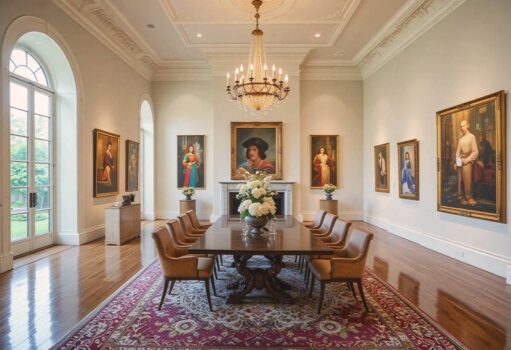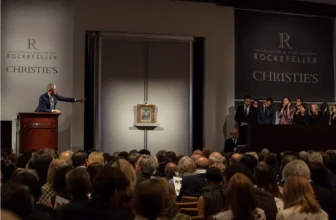Inside the World of Private Art Galleries in Mega-Mansions
In the gilded age of the ultra-wealthy, luxury has transcended cars, couture, and even castles. Today’s billionaires and cultural elites are building something far more personal , private art galleries inside their mega-mansions. These are not simple display walls or living room accents; they are carefully designed sanctuaries of art, curation, and legacy. From Beverly Hills to the French Riviera, the modern mansion has evolved into a private museum , a hidden Louvre that exists behind closed gates.
This article explores the rise of in-house art galleries, the architectural and emotional motivations behind them, the design considerations that make them possible, and how collectors are shaping art history from the privacy of their own homes.
The Rise of the Private In-House Art Gallery
Luxury Real Estate Meets Cultural Legacy
Once, private art collections were hung in dusty halls or secret rooms reserved for family viewing. Today, they are integral to the architecture itself. Architects and designers now collaborate with curators, lighting experts, and conservationists to build in-home art galleries that rival public institutions.
The global luxury real estate market has shifted toward personalization , homes are now reflections of the owner’s passions and identity. For collectors, art is not merely decoration but a statement of intellect, taste, and permanence. A billionaire’s art gallery tells a story that goes beyond financial success , it signals cultural sophistication.
The Pandemic and the Private Museum Boom
Interestingly, the 2020s saw a surge in private art galleries as lockdowns and travel restrictions kept collectors away from museums and fairs. Instead of lending works to public institutions, many collectors turned inward, commissioning architects to create private spaces for reflection and exhibition.
For example, Los Angeles art collector and tech investor families began converting entire basements and wings of their homes into museum-grade environments , with humidity control, non-reflective glass, and track lighting designed to preserve priceless works.
From Living Room to Louvre: The Evolution of the Private Gallery
A Tradition of Private Patronage
Private art display has a long lineage. The Renaissance Medici family in Florence showcased their collections inside palaces that became the blueprint for modern museums. Fast forward to the 21st century, and that spirit has returned , except today’s collectors are not commissioning chapels but building climate-controlled sanctuaries within their mansions.
In a sense, the mega-mansion gallery is the new form of patronage. Collectors who once donated works to museums now prefer to preserve them privately, creating microcosms of world culture within their homes. These are not ostentatious showrooms but intimate spaces , often shared only with select guests.
Architectural Integration
Modern mansion galleries blur the boundary between living space and exhibition space. Designers integrate gallery corridors, floating staircases, glass partitions, and concealed lighting to create flow and contrast between art and architecture.
In Miami and Dubai, architects incorporate daylight-calibrated lighting systems and even AI-driven humidity sensors to ensure art remains pristine. In Aspen, glass-enclosed galleries overlook mountain ranges , combining nature’s beauty with curated creativity.
Exploring the Private Art Worlds of Mega-Mansions
Art as Lifestyle
Inside these galleries, art is not separate from life , it is life. Many collectors curate spaces to reflect their personal evolution: early works they bought as emerging investors hang beside Renaissance masters acquired decades later. Every wall tells a story.
For instance, in a Malibu clifftop mansion, one collector displays kinetic sculptures that move with ocean breezes, while another in Manhattan integrates digital art displays that change dynamically through NFT synchronization.
Art has become interactive, personalized, and living , part of a dialogue between the homeowner and the work.
Hidden Museums: Exclusive Yet Influential
While these private galleries are closed to the public, their influence reaches far beyond their walls. Collectors often loan pieces from their personal collections to major institutions like the Guggenheim or Tate Modern. In doing so, they quietly shape the global art narrative , deciding which artists gain exposure and historical importance.
Private museums such as the Broad in Los Angeles or the Rubell Museum in Miami began as private collections within homes before evolving into full-scale public spaces. Many of today’s mega-mansion galleries could be the future Broad Museums , seeds of cultural institutions waiting to bloom.
Building a Private Art Gallery That Outlives the Mansion
The Philosophy of Permanence
A private art gallery is not built merely for admiration , it is built for posterity. Collectors often see their in-house museums as multi-generational legacies that will outlast the mansion itself. Art becomes a family’s cultural DNA, an archive of values and vision.
To achieve this, every detail matters , from wall materials to temperature control. Preservation is as important as presentation. The space must protect against UV damage, moisture, vibration, and even sound frequencies that could affect delicate canvases.
Designing for Eternity
When building a private gallery, architects and curators follow the same principles as public museums:
Lighting: A mix of LED and natural light that avoids UV damage.
Climate Control: 50% humidity and 70°F temperature are standard.
Security: Hidden surveillance, motion sensors, and coded entry systems.
Flexibility: Modular walls and movable partitions to accommodate rotating exhibitions.
Some collectors even design underground vault galleries , secure, climate-stable rooms designed to preserve art in case of natural disasters. In Palm Beach, one estate includes a subterranean gallery with a retractable skylight system, blending safety with beauty.
Sustainability and Technology
Eco-conscious collectors are now incorporating sustainable materials and smart technology into their private galleries. Solar-powered lighting grids, recycled acoustic panels, and AI climate management systems make these galleries efficient and green.
Meanwhile, digital archives preserve high-resolution 3D scans of every artwork, ensuring their digital afterlife. This trend mirrors how art institutions use technology for preservation, documentation, and remote curation.
Private Passions: How Collectors Curate Their Own Hidden Museums
The Psychology of Collecting
Why do collectors go to such lengths to build private museums? The answer lies in passion , and power. Art collecting satisfies a deep psychological drive for possession, understanding, and self-expression. Each acquisition is both an investment and a reflection of identity.
For some, a private gallery is a way to build a world entirely under their control , one that mirrors their aesthetic vision. For others, it is a spiritual retreat, a sanctuary from the chaos of modern life. Art becomes a mirror to the soul and a monument to taste.
Curating a Personal Narrative
Unlike public museums, which organize works by era or geography, private galleries are free from convention. Collectors can display art chronologically, thematically, or emotionally. A minimalist collector may showcase only monochrome works in a meditation-like chamber; another may create immersive spaces combining sculpture, video, and sound.
The layout itself becomes a form of autobiography. Each gallery is a portrait of the collector through the lens of their collection.
The Business of Private Art Galleries
Tax, Trusts, and Investment Strategy
Beyond aesthetics, private galleries play a role in financial strategy. Art is now considered a legitimate asset class, and many collectors use their private galleries as part of family trusts or art funds. The mansion itself becomes a secure vault for appreciating assets.
Some ultra-high-net-worth individuals even host private showings for invited guests, investors, or curators, blending social prestige with market influence. An in-house gallery can increase the value of the mansion itself , luxury real estate developers have reported that properties featuring exhibition-quality art spaces sell faster and command premiums of 15–30%.
The Art of Secrecy
Despite their wealth, many collectors maintain privacy. Their galleries are known only through whispers , occasionally revealed in glossy architecture magazines or celebrity profiles. This secrecy adds allure, creating a mythology around their collections.
Collectors like François Pinault, Leon Black, or Dmitry Rybolovlev maintain private spaces where masterpieces by Picasso or Rothko hang unpublicized. Their homes become living museums of secrecy and sophistication.
Architectural Trends in Private Art Galleries
Minimalism and Materiality
Most in-house galleries follow a minimalist design philosophy , white walls, polished concrete floors, and hidden lighting. The architecture recedes to let the art dominate. Materials like limestone, oak, and steel are chosen for their neutrality and durability.
In London’s Knightsbridge, some mansions integrate double-height art halls with glass bridges, offering cinematic perspectives. In Los Angeles, open-air galleries allow sculptures to merge with surrounding landscapes, echoing the concept of art in dialogue with nature.
Hybrid Spaces
Modern luxury homes increasingly feature hybrid art spaces , blending gallery, library, and lounge. A collector might host a dinner surrounded by Basquiats, or meditate beside a Rothko. These flexible spaces encourage living with art rather than merely displaying it.
Iconic Examples of Private Mansion Galleries
David Geffen’s Malibu Compound: Features museum-grade lighting and a rotating display of contemporary art, rivaling public galleries.
Mukesh Ambani’s Antilia in Mumbai: Includes entire floors dedicated to art, blending Indian and global works.
François Pinault’s Venetian Residences: Host private previews of the billionaire’s extensive modern art collection before public exhibitions.
The Broad Residence in Los Angeles: Once a private home gallery, it evolved into a public institution showcasing works from Jeff Koons to Cindy Sherman.
These examples illustrate a continuum , from private obsession to public contribution. What begins as personal passion often becomes a cultural legacy.
How to Build a Private Gallery: Expert Tips
For those dreaming of turning a home into a haven for art, here are practical guidelines:
Start with the Art – Let the collection dictate the space. Paintings require different lighting and climate controls than sculptures or media installations.
Hire a Specialist Architect – Work with designers experienced in museum or gallery projects.
Prioritize Preservation – Invest in conservation systems; temperature and humidity control are non-negotiable.
Think Modular – Use movable partitions or panels for flexibility as your collection grows.
Blend Function and Emotion – Create an environment that inspires contemplation, not just display.
Document and Digitize – Maintain detailed records and digital backups of every piece.
Plan for Legacy – Consider future ownership, family trusts, or donations. A private gallery should live beyond its walls.
The Future of Private Art Worlds
As technology advances, private art galleries will evolve into immersive, AI-driven experiences. Virtual reality rooms, digital twins of collections, and blockchain provenance systems are redefining ownership and exhibition. Soon, collectors will host virtual tours of their mansion galleries , accessible only to invited guests through secure metaverse platforms.
The next generation of collectors , often tech billionaires or crypto investors , are merging traditional art with digital assets. NFTs, holographic installations, and generative AI art are finding their way into the physical mansion gallery, creating a fusion of old-world elegance and new-world innovation.
Private Passions, Public Legacy
Private art galleries inside mega-mansions represent more than wealth , they symbolize the intersection of culture, architecture, and individuality. They are where personal stories meet artistic genius, and where the walls of a home become the walls of a museum.
From the Medici palaces of the Renaissance to today’s smart mansions in Malibu or Monaco, the tradition of private art patronage continues , evolving, expanding, and redefining what it means to live with art. These private sanctuaries remind us that while public museums preserve history, private galleries preserve identity.
And perhaps, centuries from now, the hidden art worlds within these mansions will open their doors , transforming private passion into shared heritage, and living rooms into legacies.




